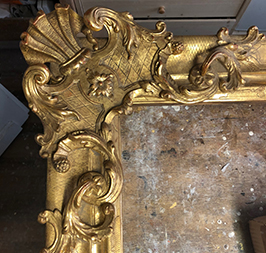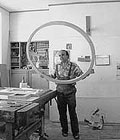 |
||||||||||||||||
| virtual Studio | References | Workshops | Styles of Frames | History | Collection | Gallery | ||||||||||||
|
|
||||||||||||||||||
| The Gilder's Workshop Here gilding techniques are carried out in accordance with very old formulae and methods. The Carpentry Department Here the wooden moulding blanks are created according to old techniques and with a range of different corner joints. The creation of picture frames demonstrated with photographs Creation of the frame for the State Museum Kassel, Old Masters Picture Gallery Creation of the frame for the Pfalz Gallery in Kaiserslautern |
||
|
|
||
 |
The gilding Workshop The techniques of craftsmanship have not changed in centuries. |
 View into the gilding workshop at the rear of the show rooms at Nr. 5 Gewürzmühl Street. Eight gilders work here (the old guild name is “Fassmaler”), some of them in the second generation. Since the 1960s, well over 50 apprentices have been trained in this gilding workshop. Several of the trainees have succeeded in winning federal prizes in their handicraft.  A gilded frame is receiving patina treatment. |
|
The blank frames made in our own carpentry workshop are further crafted in the gilding workshop and prepared for bole gilding. This can be composed of up to 15 single coatings. One differentiates between two main coatings: the mixture of finely powdered whiting and size, and the bole base. |
||
|
|
||
 |
Here craftsmanship is just as much in demand as is the competent use of spezialized machines and the knowlege of historical wood compounds. |

View into the carpenter's workshop. In the middle of the machine room is the moulding cutter. A frame often consists of several profiles wich have to be milled seperately. |
| Each frame construction begins in the carpentry workshop. With the help of a profile scanner a sectional drawing is made of the original frame. The original profile is suitable often only for a certain framework size, and so the profile has to be altered to scale to suit a frame with narrower or boarder sides. Next - dependent on the surface - the most suitable wood is selected: pear for Dutch frames with polished black contours; cherry, mahogany and ebony for frames contemporary to the Biedermeier era; alder and pine woods as a base for gold leave applications. In the drying room the exotic woods are air-dried over many years before they are further processed. | ||
| The woods are milled and inspected for accurate agreement with the original profile. After completion the profile frame is glued onto a blank frame which has been manufactered with traditional wooden joints such as halved joint, tenon-and-mortise, dovetail or swallowtail key. The carpentry workshop also manufactures special items. For the karl Pfefferle Gallery it built a pavilion as a transportable exhibition booth according to plans drawn up by the Viennese architect Adolf Krischanitz. |
 We produce the moulding cutters in the carpentry workshop according to sectional drawings. |
|
